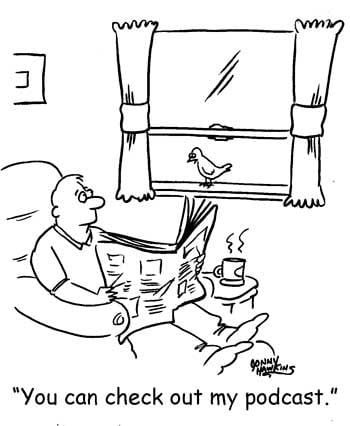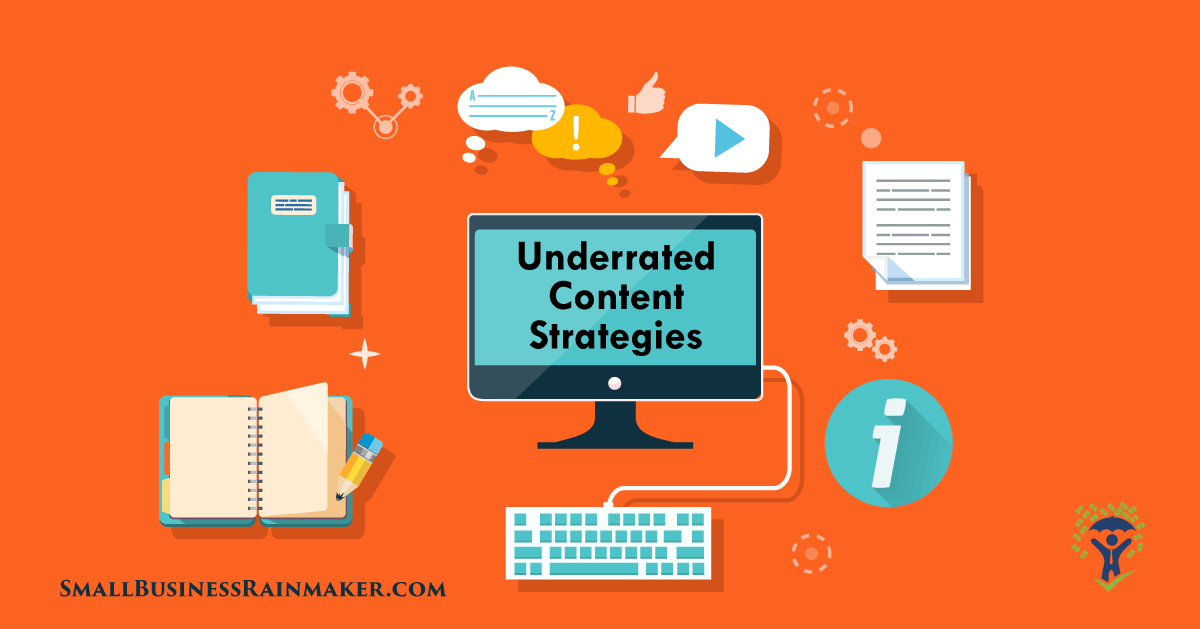A recent social media infographic taunted me with, “Tweet ten times a day. Post 2-3 times a day on Facebook. Post 1-2 times a day on LinkedIn. Instagram—post whatever I can tolerate as long as I never stop or change the frequency.” Ugh. As if there isn’t enough to do running a small business, now I’m going to dive into another internet rabbit hole?

Although expert recommendations for social media posting vary according to circumstance, they all have one thing in common. They recommend daily activity on your most effective channels.
If you’re like me, that’s enough to make us forgo social media entirely. Yet I’m sure most of us agree that a social media presence is indeed necessary to remain competitive.
How is a small business owner to keep up with the demands of daily content creation?
It’s not as bad as you think. About fifteen years ago, before “content” was king, I had a couple of experiences that taught me how to keep up with these demands.
I had started a weekly email and a monthly print newsletter. That meant I needed a bunch of content every week and more at the end of the month. In the beginning, creating content was easy.
For about 20 years prior to that, I had been the person who was now my target audience. So, I knew how to talk to myself…in a marketing sense. (I still talk to myself the other way too.)
All I had to do was share helpful tips, drawn from my manufacturing experience, that would help my ideal client. Anything that made their lives and their jobs easier would naturally appeal to them. I didn’t worry about running out of content. There’s a lot of stuff you learn in 20 years.
Then, a couple months after starting the email newsletter, one of my subscribers came up to me at a trade show and said,
“What are you going to write about when you run out of things to say?”
He was an influencer and author in the industry, and it caused me to doubt myself.
At first I thought he didn’t like having another writer (me) on the block. Most industries are insular and tribal in nature. I had escaped my proper place on the shop floor without “permission,” and without “working my way up the ladder.” I just started writing and blogging about my experience and how it could help others.
The newsletter was great at opening doors, getting appointments, and selling products. My success at doing that is what got this influencer’s attention. (He also told me later that I had “moved his cheese.” Our product had caused a slight decline in his easy, high-profit sales.) Tribe members don’t like renegades.
I took his comment good naturedly and wrote it off as an attempt at humor. Yet his comment got me thinking about content. Do we ever run out of stuff to talk about when we’re at work? No. Never.
Every day presents at least one new problem, idea, or opportunity. If you want content, just pick one of those and talk about it. One idea breeds ten more ideas. There is a wealth of resources available in our everyday experience.
Many years and a few hundred articles later, I have no doubts about ever running out of useful things to talk about and share. It’s not going to happen.
I admit, when you look at the amount of content required – on a daily basis – it can be overwhelming, especially if you think you have to do it all by yourself. Or when you’re starting a new business.
Yet you don’t have to do it by yourself. Nor do you have to create something new from scratch every day. Here are ten tips I’ve used to create years of content without getting overwhelmed.
1) Stop and Breathe
We’re all small business owners. Most of what we do happens one client at a time, especially in the beginning. So, relax. Take a breath. You might just have to make one phone call, one social media comment, or one email today to get a high-quality interaction. I’ve written about the “power of one” before. It goes a long way.
Once you create a plan for your social media activity, it will happen. But not all at once. Stop and do your plan.
Without a content plan, you’ll be frustrated and won’t get much from the time spent on social media. Your plan should include an outline of all the content you’ll need for a certain time period, what you want to include in the content, and a deadline for getting it out there.
Make it an attainable goal. Your plan can be very simple at first, maybe one blog post a week or every other week, posted to social media when done. Or one email newsletter a week.
As you put your plan together, continue to go for one good connection or conversation per day. That’s pretty easy. And it gives you room to breathe.
The idea is to commit to it and make it good.
2) Make a List of Your Assets and Use Them
I’m not talking about balance sheet assets. I’m talking about a list of all your skills, all your knowledge and experiences, and all the people you know, both personally and professionally.
Many business and personal coaches recommended this insightful exercise. Lee Milteer, Carrie Greene, Claire Caines, James Altucher, and Jay Abraham all recommend doing this in one form or another, to discover the value you can provide for others. That's what we want to do in our social media efforts—supply value to prospects and clients.
My asset list started with about a dozen things. Now it has at least 100 items. (As I’m writing I just thought of 7 more things to add.) When you make your list, you’ll start to see connections with how it can help your clients. When you see how your experience, skills, knowledge, and contacts can help others, you can create content to answer those needs.
An example. I had a lot of experience selling a B2B product with demonstrations at the customer’s place of business. That experience is an asset. From the questions I was asked during those demos, I got the idea to start a newsletter. All those questions became FAQ’s on our website. All those questions became blog articles. Many of the questions became how-to videos. I drew on one asset—B2B sales experience—to create lots of valuable content.
3) Tap the Content Assets in Your Staff
Unless you’re a solopreneur, your staff has many lifetimes of work and personal experience to draw upon. They have a wealth of untapped assets that can be used in your business.
They don’t have to be skilled writers, artists, or other producers of content. You can interview them on topics about which they’re passionate and knowledgeable. Then cover it in your blog and newsletter. Ask them what they’re interested in contributing. Ask them what skills they’d like to use in their job that they’re not using. You might be surprised by the depth of these assets, and they will be delighted.
4) Tap the Content Assets from Your Vendors
Whether you’re a solopreneur or a well-staffed small business, you work with a few vendors. Many vendors have excellent content available for the asking. The great vendors make a deliberate effort to have and distribute content that helps their customers to sell the vendor’s product.
One example of this is Sappi Paper’s Education and Support page. They’re a paper manufacturer that sells to printers and packaging companies around the world. They have dozens of technical and design publications available for free. If you run a printing or packaging company or a design agency, you can use this awesome resource to educate your clients.
If your vendors aren’t great content creators like Sappi, they can still be a good source for ideas. You can interview them in writing, on the phone, or on video. Talk to sales and technical reps when they come in your shop. They are a tremendous source of information. Ask them questions that ultimately relate to solving your customer’s problem. Any good vendor will be happy to help you help your clients. It’s then up to you to turn it into content your clients desire.
5) Tap the Content Assets from Your Ideal Customers
Get to know your best customers and document what makes them tick. Ask to interview them for your newsletter or blog. Pay for articles or how-to tips submitted by them for the newsletter. Read their blogs and newsletters to search for content and ask to re-use relevant articles.
If you have a compelling client success story, do a case study and then issue a press release to your trade publications. Unless there are non-disclosure issues, clients will be happy to oblige, especially if they get a little press or social media interaction from it.
When your ideal customers have a presence on your blog and website, it will attract more of the same type of customer.
6) Re-Use Existing Content
 One thing all the pros do is re-use content. Check out your favorite bloggers. You’ll see them re-posting articles that might have been written years ago. They never post good content just once. One article might be posted a few times a week on several channels, for months on end. Timing will vary.
One thing all the pros do is re-use content. Check out your favorite bloggers. You’ll see them re-posting articles that might have been written years ago. They never post good content just once. One article might be posted a few times a week on several channels, for months on end. Timing will vary.
The value of evergreen content doesn’t dissipate. Maybe a few tweaks and edits will be needed to stay current, but the inherent value can be timeless.
There are tools to help with this too. Meet Edgar, Recurpost, Hootsuite, and dozens of other apps will post evergreen content automatically. I won’t go into details here about the tools themselves because it’s all available online.
The point is that the pros use a mix automatic tools along with manual posting to keep their good content circulating.
7) Re-Purpose Existing Content
Make a list of all your content assets such as blog posts, social media posts, email autoresponder series, opt-in reports, bonus reports, product reviews, sales letters, white papers, customer service scripts, case studies, videos, FAQ’s, podcasts, articles, and so on. Nearly every item can be re-purposed into another item or in a different media.
For instance, blog posts can be turned into an auto responder series, or a podcast, or videos, or FAQ items. Take your top ten blog posts and turn them into podcasts and you quickly have a ton of new content. When it’s re-purposed, of course you then post it all again on social media. Repeatedly. Everything can be re-purposed into something else. This has an almost exponential effect on your content creation capacity.
8) Write Down 10 Ideas a Day
This is a powerful idea I learned from James Altucher in his book, Choose Yourself. Altucher writes,
"People have lots of ideas, but they are mostly bad ones. The way you get good ideas is to do two things: 1) Read two hours a day. 2) Write ten ideas a day. By the end of a year, you will have read for almost one thousand hours and written down 3,600 ideas. One of those ideas will be a home run."
It's a simple technique but it works. I don’t quite get two hours a day of reading in, but I write down 10 ideas. Ideas about anything and everything. It doesn't matter as long as you get them down on paper. It’s training for your brain. Try it and you’ll see what happens.
9) Work with a Freelance Writer and Editor
Develop a working relationship with a writer you trust, who knows your style, and who is familiar with what you require. Look for someone whose talent enables them to speak “for” you with minimal tweaking.
There are plenty of freelance resources available online and locally. Even if you plan to outsource, you should still know writing and editing basics. You want to ensure you’re getting what you need from your freelancer.
One caveat: don’t go for the cheapest. We talk about the pitfalls of outsourcing here in a recent Small Business Rainmaker newsletter.
10) Use Social Media Itself to Source Content and Inspiration
Turn the tables on the social media beast and let it feed you content instead of devouring your time. Follow people who cover topics that can help your customers. Follow people who inspire you. Their ideas will spark your imagination. Set aside time to read their content.
When you find a valuable nugget that will enlighten or inspire your clients, simply share it on all your channels.
Then you can take it one step further. Ask for permission to reprint relevant blog articles on your site or in your newsletter. Most authors are very happy for this type of opportunity. They get more exposure and you get ready-made content.
Take it even further. Compile several articles that could help your customers and reprint them (with permission) in a book or magazine format. Send them to customers and prospects to answer their questions and build credibility. Or put them in an ebook format. It’s easier to do than you think. Blurb.com prints high quality books and magazines in quantities as low as one, and also does e-books.
With a little reflection on the ten ideas above, your content will appear faster than you can use it. You and your co-workers are rich in experience, knowledge, and skills. You need never worry about running out of things to say.
As you start to post according to your plan, you’ll see the beast starts to feed you not just with content, but with new leads, connections, and opportunity.
That’s exactly where you want to be. And like Alice going down into the rabbit hole, maybe the indirect route will turn out to be both fascinating and productive.















Leave a comment